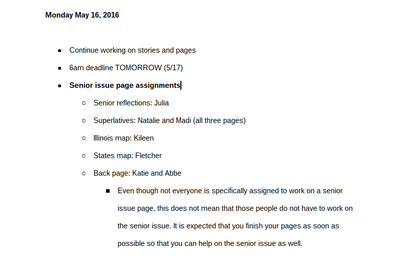Copyright Presentation
After returning from the 2016 JEA/NSPA convention in Indianapolis, I felt the need to share with the staff some information that I took notes on from SPLC director Frank LoMonte's presentation on copyright law. When it comes to copyright law, all of the editors on my staff, including myself, are constantly confused on what is legal and what is not. Putting together the presentation not only allowed me to educate my fellow editors, but also gave me the opportunity to work through and organize the information for myself and create a deeper understanding. My slide show presentation is below.
In Design lessons
For the last two years, I have ran interactive In Design lessons at the beginning of the school year for the new staff. This is usually very informal, with me on the overhead screen talking through how to use certain In Design features and then having the other editors replicate my actions on their computers. Although returning editors find these lessons repetitive, I think that it is critically important for us to relearn how to use In Design as a team. Having veteran editors work alongside newbies also is great for encouraging editors to get to know each other and help each other out.
Agendas
Last year, my schedule ended up working out perfectly and I was able to aid in the journalism office 4th period with my fellow editor-in-chief. This was extremely convenient because our journalism 2 class with all of the section editors was 5th period. During our aiding period, we often helped out adviser put together agendas for class that day. It was great to be able to figure out a "game plan" every day before class and we collaborated as a team to figure out the key things that needed to get done that day. Examples of agendas I created are below (click to enlarge).
Communication & Meetings
One of the biggest struggles of being in a leadership position in high school is finding the healthy medium when it comes to leading your own peers. It can be really odd going from being equals in any regular class to having distinct leadership positions over your peers on the newspaper staff. Twice in my past two years as editor-in-chief, I have had to have serious discussions with editors about work ethic and "pulling their own weight". For these two situations, my fellow editor-in-chiefs and I had to have the much avoided conversation with editors about removing their name from our staff box. We take a lot of pride in our publication and want to make sure that the people being recognized for doing good work are actually doing the work. These meetings had positive outcomes because the confronted editors recognized their faults and worked harder following issues.
Throughout the month, I conduct informal section meetings usually twice a week. This usually just entails sitting down for a couple minutes with the section editors to discuss the progress of the content and design of their pages for the month. I also offer advice on design and which content to publish during these meetings. Once the stories become somewhat developed, I often go around to all of the section editors and write down the different stories, photos and graphic element they plan on including. Frequently touching base with section editors allows me to have a more realistic idea of where the paper is at. The last thing I want to do is get to the final deadline meeting and find out that one of our main articles for the issue is underdeveloped and the page is not designed.
Throughout the month, I conduct informal section meetings usually twice a week. This usually just entails sitting down for a couple minutes with the section editors to discuss the progress of the content and design of their pages for the month. I also offer advice on design and which content to publish during these meetings. Once the stories become somewhat developed, I often go around to all of the section editors and write down the different stories, photos and graphic element they plan on including. Frequently touching base with section editors allows me to have a more realistic idea of where the paper is at. The last thing I want to do is get to the final deadline meeting and find out that one of our main articles for the issue is underdeveloped and the page is not designed.


